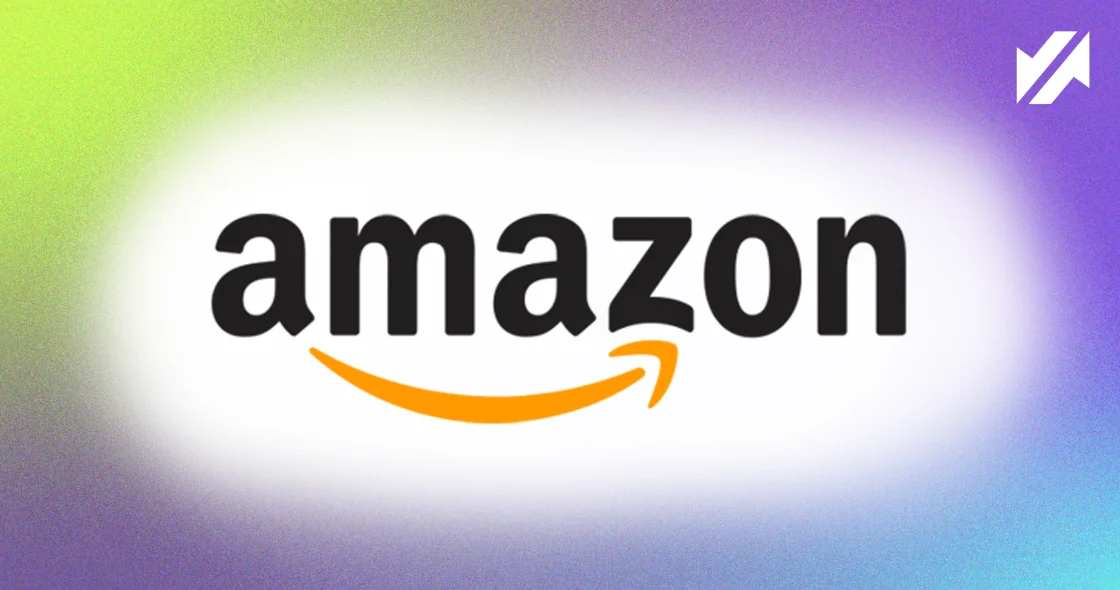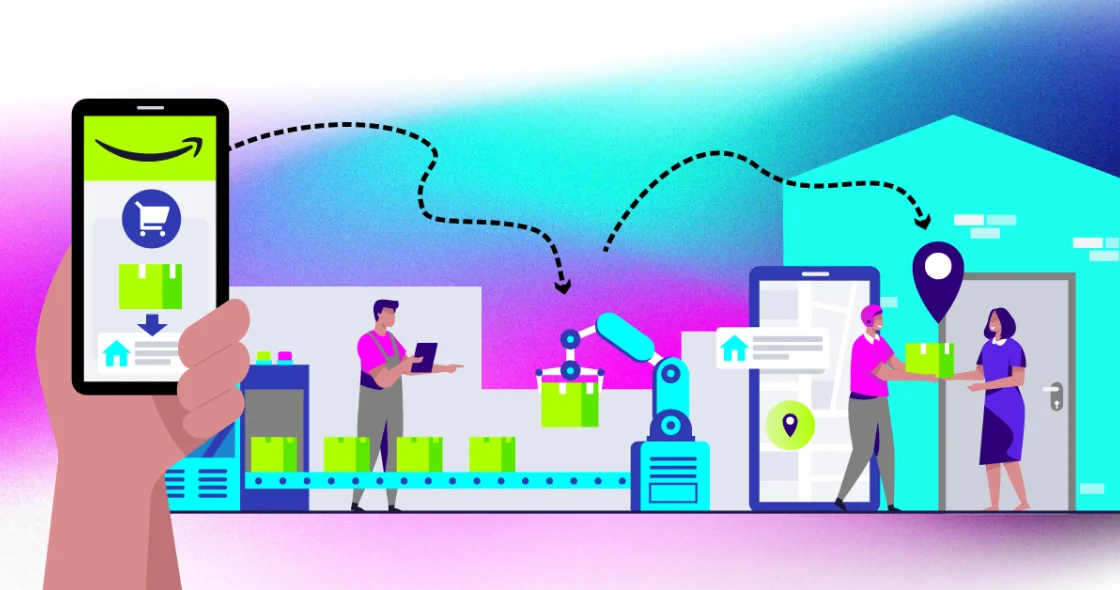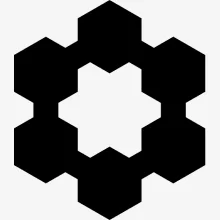Attribution models are like a payroll engine 💰 – they know who and how much money (or credit) to assign to each person (or user touchpoint) in a set period of time.
If you think about a recent tool you discovered and started using for work, you likely spent a bit of time doing any combination of the following: researching them on Google, visiting their social media accounts on Facebook and Instagram, signing up for a demo or consultation, and/or browsing reviews about them from sites like G2 and Capterra.
The sequence of events you took and how much each marketing touchpoint is worth, are acquisition paths that are crucial for any business to understand. These paths can be mapped to show the ones with the highest conversions, revenue, ROI, and LTV.
Attribution models are spotlights that shed light on this pain point of mapping your customer touchpoints to conversion outcomes you care about, and more.
In our complete beginners guide to marketing attribution models, we’ll take you through:
- What marketing attribution models are
- Why attribution models are important
- The 7 main attribution models
- How to choose the right attribution model
Plus a bonus infographic at the end you can download for easy reference on attribution models. Let’s get started!
What Are Marketing Attribution Models?
If you’re a digital marketer who’s had to run online ads on Facebook or Google in the past, you’re likely familiar with or heard of last touch attribution – the most common attribution model used by ad platforms. But what do marketing attribution models actually do?
Marketing attribution is the method for identifying and assigning credit to each marketing touchpoint that leads to an important event, such as a purchase. This is done through marketing attribution models.
Marketing attribution models use a set of rules to dictate how much weight and credit to give to every touchpoint along your customer paths to conversion.
There are many different attribution models used in the industry, and each of them assign credit to your customer touchpoints differently.
We’ll take a look at 7 major attribution models, and why each of them help uncover different insights about your marketing and product growth strategy, based on your goals and business.
Why are attribution models important for your business?
Imagine getting the gift of laser surgery and 20/20 vision, after having horrible nearsighted vision for most of your life 😎.
Many marketers are still measuring conversions and doing attribution with a near-sighted approach, where they only see one part of the conversion path, and the rest is a blur.
Especially since ads platforms like Google and Facebook automatically default to last-touch attribution, where they only give credit to the last platform a user visited before converting, and neglect all other platforms visited.
It can take at least 8 touchpoints to close a sale, and the options people have to engage with your business continually grow and become more complex. So it’s also become increasingly important to have an eagle eye’s vision of everything that’s happening in your customer journeys.
By using attribution models to measure all your customer touchpoints, it’ll help you:
- Track the impact of each channel, and where they fit in conversion paths.
- 💰 Invest in your best channels that drive ROI and LTV, and stop underperforming campaigns.
- 🚀 Understand customer behaviors and acquisition tactics that increase retention.
The 7 Main Attribution Models
To truly get a 20/20 view of what’s happening across your customer paths, and understand which marketing efforts and campaigns convert best, you’ll want to analyze multiple marketing attribution models.
There are two types of attribution models:
- Single touch attribution: Credit for a conversion gets assigned to only one touchpoint.
- Multi-touch attribution models: Credit for a conversion gets assigned to every touchpoint, so you get a full picture of your customer journey.
We’ll dive into each of the 7 most common marketing attribution models, and their pros and cons below:
- First touch attribution
- Last touch attribution
- Linear attribution
- Time decay
- U-shaped attribution
- W-shaped attribution
- Custom attribution
For each of them, we’ll use this example SaaS customer journey with a fictitious customer, Charles:

Charles had 5 touchpoints, from his first touchpoint on a Google Ad, to the last touchpoint from a direct website visit that led him to become a paying subscriber.
Single Touch Models
1. First Touch Attribution Model
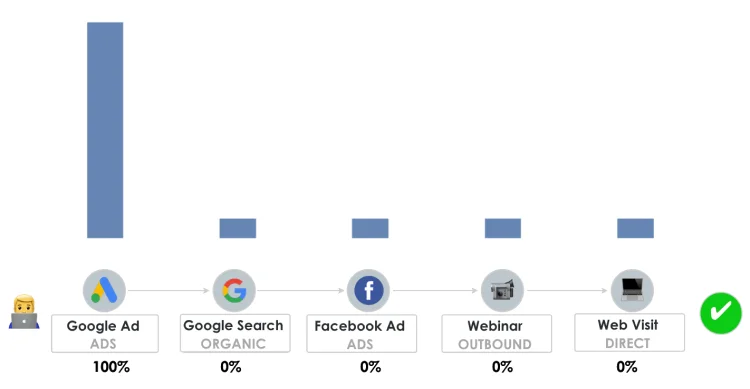
First touch attribution gives 100% of the credit to the first touchpoint that brought a visitor to your website. In this example, your Google Ad would receive 100% of the credit for the conversion, and all the other 4 touchpoints would receive 0%.
🎉 Pros: Single touch models are simple and straight-forward to track. First touch attribution helps you understand how people discover your business and which channels to invest in for brand awareness.
🙅Cons: Since all credit is given to only the first touchpoint, this doesn’t take into account all the other channels that also contributed to a conversion. This means you may overspend on Google Ads, when in reality, it may be a combination of both Google Ads and creating SEO-powered content for organic search that fuels your brand discovery.
2. Last Touch Attribution Model
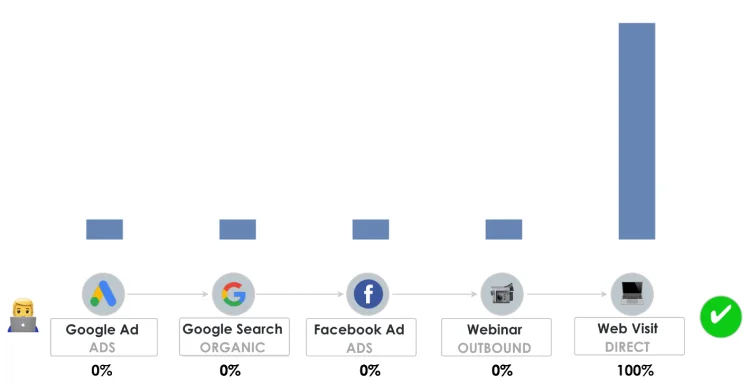
Last touch attribution gives 100% of the credit to the last touchpoint right before a visitor converted on your website. In this example, Direct would receive 100% of the credit for the conversion, and all the other 4 touchpoints would receive 0%.
🎉 Pros: Again, just like first touch attribution, last touch models are easy simple to track. Last touch helps you understand which channels led visitors to convert directly. This is the most common model used in ads platforms, and is particularly useful if your goal is to acquire new customers.
🙅Cons: Giving all the credit to one channel, means you give zero credit to the other channels that contributed to a conversion. In this example, it can lead you to oversimplify your strategy and only focus on tactics that drive visitors directly to your site. When in reality, it’s a multi-stage decision-making process, where online ads, SEO, and webinars all impact the conversion too.
Multi-Touch Models
3. Linear Attribution Model
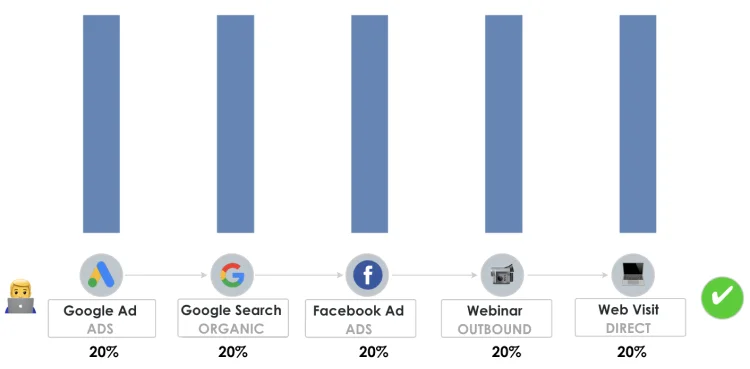
Multi-touch linear attribution evenly distributes credit to each touchpoint along a visitor’s journey to conversion. In this example, each of the 5 touchpoints from Charles would receive 20% of the credit for the conversion, as they all played a role.
🎉 Pros: This is the model people primary look to when investing in a marketing attribution solution, as it shows the full picture of each touchpoint that contributed to a conversion.
🙅Cons: Since linear attribution models assign equal weight to each touchpoint, if you have a long sales cycle or know some channels (e.g. online ads) generate higher revenue than others (e.g. in-person events), you can’t allocate different credit to them to better inform where to spend your time and money.
4. Time Decay Attribution Model
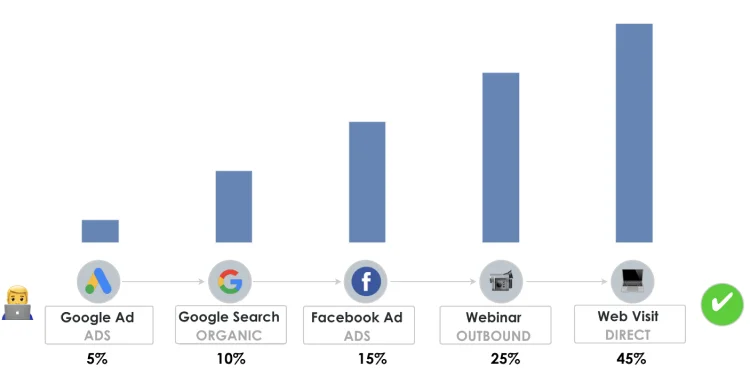
Time decay attribution increasingly allocates more credit to each customer touchpoint that gets closer to the conversion. This means the first touchpoint gets the least credit, and the last touchpoint gets the most credit.
In this example, the Google Ad would get the last credit, and your website direct visit would get the most credit.
🎉 Pros: If you have a long sales cycle, this multi-touch attribution model recognizes that not every touchpoint is created equal. It assumes touchpoints closer to the sale, such as a demo or webinar, may have greater weight on the purchase decision compared to exploratory touchpoints earlier on in the discovery phase.
🙅Cons: Time decay may lead you to optimize only for latter touchpoints, as it assumes that the first few touchpoints didn’t have a great impact. But in various scenarios, the early touchpoints may in fact have been equally as important to the conversion. For example, by placing less weight on Google Ads, you may get less people signing up for your high converting webinars, as there’s less opportunity for them to find out about you.
5. U-shaped Attribution Model (or Position-Based Attribution)
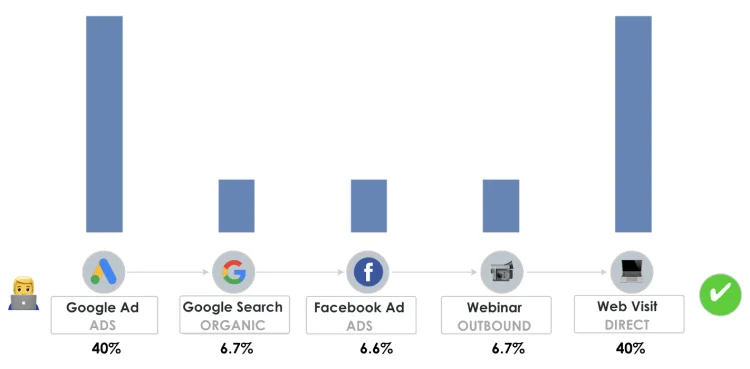
U-shaped attribution assumes your first touchpoint and last touchpoint are the most critical parts of your customer journey. It gives 40% of the credit to each the first touchpoint and the last touchpoint, and divides the remaining 20% evenly amongst all the touchpoints in between.
🎉 Pros: U-shaped attribution is like having first touch and last touch attribution combined into one model. It’s a good way to understand which channels impact the first impression and most effectively bring in new visitors (such as ads), as well as which channels can directly impact your conversion (such as sales demos, webinars, or live chat).
🙅Cons: Since 20% of the remaining weight is distributed amongst your middle touchpoints, again, this assumes that they have much less impact than the first and last touchpoints, which may not always be true.
6. W-shaped Attribution Model

W-shaped attribution is similar to U-shaped attribution, as it allocates more weight to both the first touchpoint and last touchpoint. But it also allocates more weight to one of the middle touchpoints, which is the point when a visitor becomes a lead.
In this model, 30% of the weight is distributed to the first touchpoint (e.g. discovery via a Google Ad click), middle touchpoint (e.g. lead via a webinar signup), and last touchpoint (e.g. conversion from a direct website visit). Then, 10% of the remaining weight is distributed amongst the rest of the middle touchpoints.
🎉 Pros: W-shaped attribution model can be more telling of key touchpoints in your customer journey that contribute to a conversion, as it focuses equally on the beginning, middle, and end. It’s particularly beneficial if you’re focused on lead generation.
🙅Cons: It may be unnecessary if you have a simple sales cycle. It can also be trickier to setup depending on how you track new leads, and may place too much weight on channels that generate leads, if you ultimately care about conversions.
7. Custom Attribution Model

Custom models are designed for companies with a long and complex customer journey. They’re more appropriate when you have a lengthy buying cycle, as you can assign custom weights to each channel along your customer paths.
For example, you might assign a higher weight for someone who signed up for a webinar than someone who clicked on a Facebook Ad. If lead generation is a major focus area, you might also assign different weights for different pieces of content people download – it could indicate varying degrees of likelihood to become a customer, based on the guides they need.
🎉 Pros: In theory, custom attribution is the most effective model, as you can tailor it to all your channels and set it up so you have the most accurate view of which efforts yield the highest ROI and LTV.
🙅Cons: Custom models are complex to setup and require you to have many existing assumptions and data already in place. It can also lead to heavier resources and time invested in testing various custom models to find the most effective one for your business.
How To Choose Your Attribution Model?
These are the top considerations to keep in mind:
- What are your marketing goals? For example, which part of your marketing funnel are you focused on – generating awareness, leads, or conversions? This will help you toggle between various models to determine which channels and campaigns impact each stage.
- What type of business are you? For example, if you’re a B2B SaaS business and run multi-channel marketing, the majority of our customers are interested in Multi-touch Linear attribution to start.
- How long are your average sales and conversion cycles? For example, Time Decay attribution may be appropriate if you have a long sales cycle and are focused on touchpoints that have a greater impact closer to the conversion event.
Tools that can help you measure your attribution:
- Bizible: Revenue attribution for B2B enterprises, with a seamless Salesforce integration.
- Glew: All-in-one E-commerce analytics, business analytics, and attribution planning platform.
- AppsFlyer: A leading mobile app analytics attribution platform.
- PixelMe: The first web Customer Attribution solution, that shows your customer journeys and tracks which acquisition efforts lead to the highest ROI & LTV.
Putting Marketing Attribution Models To Work
Now that you have the basics of marketing attribution and marketing attribution models, we’ve put together a visualization of the major attribution models below, for easy reference.
Note: To download the image, simply right-click on the image, then select “Save Image As” to save it to your computer.

Want to track multi-touch attribution for your website? Sign up for a free PixelMe trial 🎉. Or message us from the live chat icon in the bottom-right corner! 💬
If this article was helpful and you want to supercharge your marketing with similar content, subscribe to our Carbon6 newsletter 🥳





